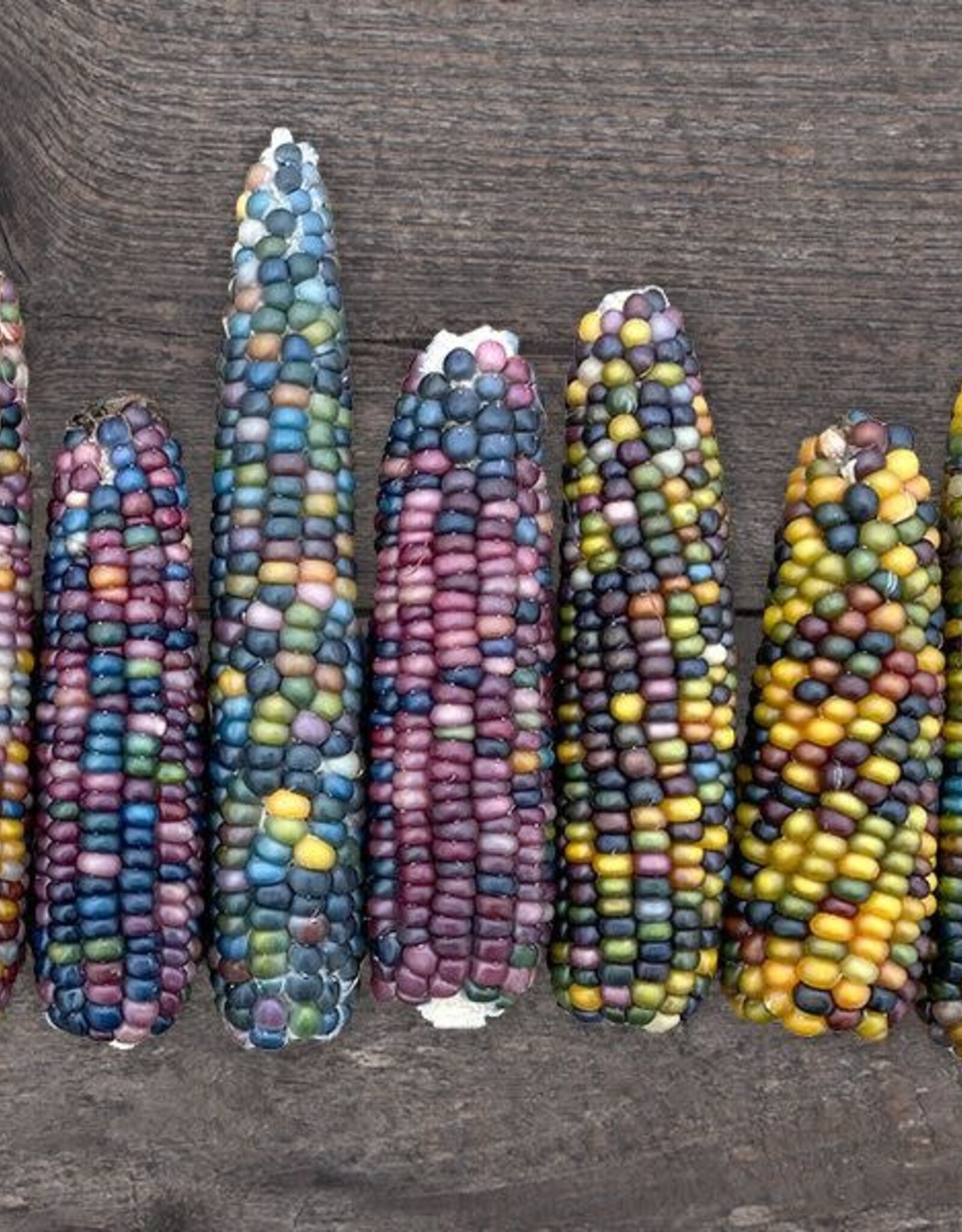HM Glass Gem Popcorn 1/2 OZ
| Availability: | In stock (10) |
Photo and Description Credit - High Mowing Seeds
Glassy, translucent kernels of unparalleled beauty.
Plants are strong, reaching 8-10' tall and high-yielding. Each 5-8" ear displays a gorgeous, unique variation of colors ranging from purples, greens and blues to oranges, yellows, pinks and deep reds. Though ornamental, kernels can be popped, ground or parched. This rare variety is the result of a cross between a Pawnee miniature corn, an Osage red flour corn, and another Osage variety called 'Greyhorse.' It was selected and preserved by the late breeder Carl Barnes, an Oklahoma Cherokee dedicated to preserving traditional Native American corns.
- MULTICOLOR
- Popcorn/parching corn
- 5-8" ears
- Open-Pollinated
Sweet Corn: 105-220 (160 avg) seeds/oz, 1.7-3.5M (2.5M avg) seeds/lb. 1 oz approx. 150 seeds. Popcorn: 235-280 (250 avg) seeds/oz, 3.8-4.5M (4.2M avg) seeds/lb. 1 oz approx. 250 seeds. Ornamental & Milling: 75-125 (100 avg) seeds/oz, 1.2-2M (1.6M avg) seeds/lb. 1 oz approx. 100 seeds. M=1,000. Direct seeding rate: 2 seeds/foot in rows 30-36" apart.
Cultural Info
Corn (Zea mays) is a warm season tender annual in the Gramineae family, which contains almost all of the grains and grasses. Corn varieties have been specialized for many uses including sweet corn, popcorn, and flint corn, which is milled into cornmeal.
Soil Nutrients and Requirements
Corn requires high fertility and deep, well drained fertile soils with a pH between 6.0-6.8. Corn can tolerate heavy soils. Corn is a heavy feeder, fertilize ground well in spring with high-quality compost or a complete fertilizer. For specific nutrient needs and application rate it is always best to have a soil test done before application. Side dress with fertilizer at 12”, or when leaves start yellowing.
Sweet corn seeds are susceptible to rotting in cool, wet conditions because their sugars are attractive to fungi and they’re growing more slowly.
Seeding Depth
Seeding depth: 1-2”
Plant Spacing
For early varieties 8-10” ”; for main season crops 10-12”
Row Spacing
Row Spacing: for early varieties 24"; for main season crops 30-36”. Plant each variety in blocks of at least 4 rows for adequate pollination.
When to Sow
Direct seed only after soil has warmed to 65°F, after all danger of frost has passed, to ensure germination. Optimal soil temperature for germination is 85°F. Corn can also be transplanted, which is becoming more common in regions with shorter growing seasons. Start transplants in small cells 3-4 weeks before planting date. Double up plants per cell to save space and increase final plant spacing to accommodate.
Other Considerations
To avoid cross pollination, separate blocks of individual varieties by at least 500 ft or plant to ensure tasseling at different times (plant varieties with different days to maturity, or use successive planting dates). Plants are in pollination mode for 2 – 3 weeks from time of tassel. If planting successions of the same variety, wait until the first succession reaches 2” before planting the next. This can be continued until 80 days before expected frost. Successive plantings of different varieties (to avoid cross pollination) should be made at 8 leaf stage of last planting.
Harvest
Harvest when ear silks have dried down and when kernels are filled to the tip and have colored up. Corn is generally ready 18-24 days after first silk has formed
Storage
For best quality, eat right away. Cool corn to 32°F within one hour of harvest. Corn will hold well for 1-4 days at 32°F and high humidity, but will decrease in sugars more rapidly at higher temps and longer duration.
Pest Info
Common insect pests include Corn Earworm, Armyworm, and European Corn Borer. The lepidopteral (worm) pests can be controlled with DiPel (Bacillus thuringiensis kurstaki, See Accessories) or Entrust (Spinosad). Removal of corn stalks or plowing in debris after harvest is the best practice for prevention to deter overwintering.
Disease Info
Corn is affected by many fungal, bacterial, viral problems. If you have a major concern, notify your local extension agent. Most common occurrences are listed here.
- Damping off caused by soil-borne fungi (Penicillium spp, Fusarium spp, Pythium spp, and several others). It is an extremely common problem when using untreated seed in cool soils. It is important to wait for appropriate soil temps before planting.
- Stuart’s Wilt (Erwinia) stewartii) is a bacterial disease spread by Corn Flea Beetles following mild winters. Resistant varieties are available that limit the spread of infection. Rust (Puccinia sorghi) is a fungal disease that the wind brings from the Southern US. Smut (Ustilago maydis), is seen in a small percentage of crops. It is most noticeable as bloated boils in ears, tassels and nodes.
- Fungal diseases are favored by moist conditions, moderate temperatures and high nitrogen.


